Color highlighting: the choice of shade and technique

The line-by-line highlighting technique by coloring and lightening has been on the list of the most popular for many years. Stylists annually propose more and more variations of highlighting, experimenting with shades, the location of highlights.
As a result, color highlighting became a separate direction in coloring.
Peculiarities
Color highlights can be multi-colored. Unlike the standard one, in this case, individual strands are highlighted, lightened and colored. The number of shades used in multicolor highlighting is unlimited. The choice of scale and shade is also varied, you can create an extravagant multi-colored image, neutral or elegant. There are the following types of highlighting:
- classic - the selection of strands occurs in one tone, only the size of the highlighted highlights and the color scheme vary;

- in American - the technique consists in combining several tones that are close to each other, as a rule, light; the transition between them is gradient;

- creative - this is a choice for extravagant and daring ladies, which implies the use of catchy, acidic, contrasting colors;

- root - carried out in the area near the roots, in fact, it is a corrective procedure;


- zonal - when a certain part of the strands is selected: the ends, the temporal part, the bangs and is gradually brightened;

- diagonal - strands are lightened at an angle;

- contrasting - performed according to the canonical technology, but the strands are chosen of different widths.


Like any staining procedure, highlighting has its pros and cons. The benefits include the following:
- the transformation takes place without harm to the root of the strands;
- suitable for any head of hair, even not differing in density;
- copes with gray hair;
- the intervals between corrections are longer;
- owners of dark colored strands can lighten without harming the structure of the entire mass of hair;
- if the color and technique are correctly selected, you can qualitatively correct facial defects and age-related changes;
- if the result is not satisfied, you can repaint;
- a huge selection of techniques and colors.

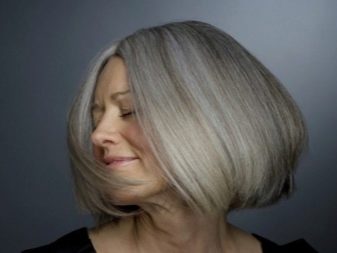


Do not forget about such disadvantages of the procedure as:
- can spoil thinned weakened strands, dry out dry ones even more;
- time-consuming process;
- high price.

How to choose a color?
Regardless of the original color and length (short, long, medium-length strands), you can choose a suitable technique and range. The structure of the strands is also unimportant, curly hair is successfully highlighted. The main thing is to take into account all the individual characteristics of your color type.
Blondes
For naturally fair-haired girls, a fairly rich palette of shades is suitable - natural and bright colors. The advantages of blond curls are that they do not require discoloration, respectively, the strands do not deteriorate, and the time costs are reduced. On a light background, it is advantageous, the following options look spectacular:
- gold;

- Emerald;


- all blue and blue scales;


- violet;


- graphite;

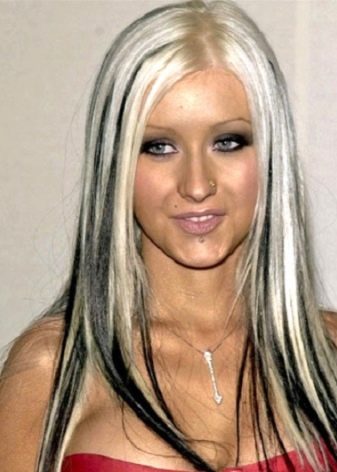
- rose and red palettes;


- redhead, chestnut.


Fair-haired
Light brown shades are especially popular in the new season, therefore, owners of this natural color are not recommended to dye it monochrome, but the row-by-row techniques will perfectly refresh the image and add an original twist to it. You can safely choose bright, non-trivial colors: fashionable pink or red-chestnut highlights. Pay attention to the shades of wheat, gold, if you want to create the most natural composition, in this version the strands seem to fade in the sun. Trendy ash highlights are perfect for this hair type.
All types of contrasting techniques are perfect for both blondes and fair-haired girls, and smooth transitions can get lost.




Dark-haired
If your natural curls are dark in color: black, brown-haired, dark blond, then any staining process with lightening will be quite long and laborious. Natural pigment in combination with oxygen and pigment can give unpredictable results, so you need to be especially careful when choosing a shade. However, it is on brunettes that the brightening highlighting techniques with a smooth transition look especially gorgeous, giving them visual volume and density. Stylists recommend paying attention to the following shades:
- tender rose;

- violet;

- blue and blue tones;
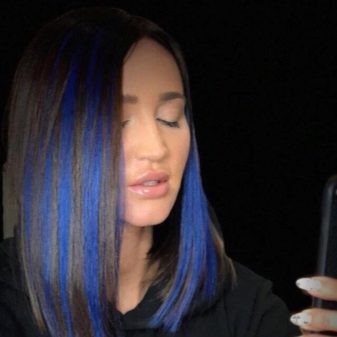

- mahogany;


- copper, honey, caramel;


- gold;

- wine and berry.


Compositions that combine shades of chocolate and honey look luxurious on a dark background. This coloration is both bright and noticeable, at the same time quite restrained, elegant and status. This is a safe bet for brunettes. Moreover, such scales perfectly refresh the face, rejuvenate the whole image. The size of the highlights and their location are not important.

Lovers of extreme sports can safely choose shades of rose and violet - this is a very playful variation. In addition, these colors are a real hit of the season. It is not recommended to carry out such combinations on your own, entrust the complex staining to a professional. Stylists recommend dark-haired young ladies to lighten the strands of the face. This technique will refresh you, make you look younger and brighter.
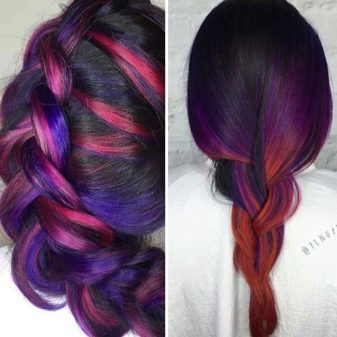

Red-haired
If your curls are naturally reddish, feel free to try orange and wheat. The play of colors will look expensive and original. You can combine lightening with strands a couple of tones darker than natural. If you want to dazzle those around you with your expressive and catchy image, try the highlights of a rose. Avoid cool tones that are too bright, such as blue.A win-win option for redheads is to highlight the bangs, a separate strand in the face area.
Important! Regardless of the type, complexion, strands and eyes, shades for highlighting should definitely be combined with your image, correspond to the status, age category and style.


Choice of paint
After you have decided on the image, you can proceed to the choice of dye. Experts agree that the quality of the paint largely determines the success of the result. Therefore, you should not experiment and carry out complex staining with paint of dubious production. If this is your first time dyeing the strands yourself, be sure to use the material from reputable companies. A known paint suitable for color highlighting is Estel Essex Lumen and Solo Contrast, Matrix SoRED, Igora Royal Fashion Lights.
Important! Before dyeing, be sure to check for an allergic reaction.

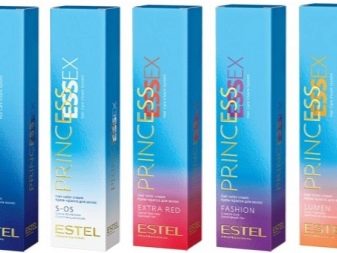


Dyeing technology
In order to carry out an independent transformation using color highlighting, it is necessary to prepare dyes and tools. Highlighting at home is carried out in different ways: with foil, a hat or without them. There are two of the most popular streak staining methods worth considering.

With a hat
This method allows you to make highlights even in the absence of any serious skills. However, there are restrictions on the length - the strands should not be longer than 15 cm, otherwise it will be very difficult to work with them. You will need the following tools and accessories:
- cream paint of the desired shade;
- oxygenating agent;
- hook and hat;
- tassel, gloves;
- plastic or glass dishes for combining dyes;
- cling film or cellophane;
- balm.
Important! You should not wash your hair before highlighting; on the contrary, it will be better if the washing process was not earlier than 2 days before the procedure.


The coloring algorithm is as follows:
- comb your hair properly, the strands should not tangle;
- put on a hat, pull the strands with a crochet, the size should be determined in advance;
- according to the instructions, mix the clarifier and cream paint;
- it is necessary to start application from the occipital zone, then proceed to the temples and face;
- cover the colored strands with foil;
- the paint should be kept for as long as required according to the instructions; it is not recommended to overexpose and wash off ahead of time, otherwise the result will be unpredictable;
- a few minutes before the end of the term, remove the film, wash off the paint;
- wash your hair with shampoo, remove the cap, distribute the balm on the strands, rinse.

With foil
If the strands are long, then the hat will not work; it is better to use special or food foil. In addition to strips of foil about 5 cm in size, prepare tools such as:
- cream paint and oxygenate;
- tassel and gloves;
- hairpins, clips, hairbrush;
- utensils for mixing the composition.


The procedure itself is more complicated than using a hat, because it looks like this:
- prepare the composition in accordance with the instructions;
- divide the strands into several zones, depending on the dyeing technology, from 3 to 8; the simplest option is the occipital and two lateral;
- start applying the dye from the back of the head, separating the strands, putting sheets of foil under them;
- roll the foil from the sides, bend;
- repeat the same with other strands;
- then proceed to the zones on the sides;
- after the time specified in the instructions is over, remove the foil, wash off the coloring composition;
- it is necessary to wash your hair with detergent and apply a balm or mask.

Important! If the strands are not blond, color highlighting includes two stages: lightening and coloring. If there are several shades, first paint with one color, after drying, proceed to another.
For those who independently want to get a smooth gradient transition with color highlighting, the following features must be taken into account:
- the pigment is not applied along the entire length, only on the bottom;
- after 10 minutes have passed, you can start distributing the paint above;
- after the next 10 minutes, the strands are combed with a large-toothed comb;
- wait for the same period and wash off the composition with running water, then with detergent and balm.


Errors and how to fix them
Among the mistakes in self-highlighting, the following are often in the lead.
- wrong choice of shade - often the color in the layout does not coincide at all with the real one, therefore, experts recommend testing and preliminary lightening of the strands; if you are performing the procedure for the first time, start with one shade;
- split strands absorb pigment more strongly, therefore they can turn darker, therefore it is better to refresh the haircut before painting or immediately after, removing a few centimeters of length;
- very often when lightening the strands acquire an ugly yellow tone, the strands should be tinted with blue pigment;
- if the highlighting result you are not satisfied, and you used unstable paint cream, just wash your hair;
- when you are not satisfied with the size of the highlights, for example, they are too thin, curling will help - the curls will perfectly hide such staining flaws;
- bright tone can be dimmed with a blend of colorless concealer and oxygen.



Care
Even if you leave the roots intact, lightening and coloring will compromise the integrity of the hair, therefore, you need to take care of them carefully, namely:
- purchase special products for colored hair - shampoo, mask, balm;
- do not wash your hair after highlighting for the first two days;
- reduce the impact of thermal tools: hair dryer, ironing, styler;
- if the strands are lightened, regularly use shampoo with pigments in violet and silver shades.



Successful examples
In the current season, the pink-violet range is very relevant, it is ideal for highlighting.

Black hair is a great backdrop for contrasting highlights.

A very effective way to revive the image is to color the ends of the strands with a different color.

Color highlighting is not always bright and defiant, it can be performed in a restrained range.


Light brown hair is a great backdrop for a graceful, elegant composition.


See the following video for the process and tips from a color highlight specialist.








